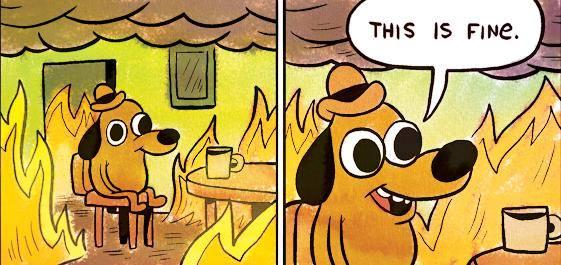The biggest concern I had in 2019 when planning my SLS English 1101 class—"This is fine: Humor, Media, and Climate Change”—was climate change. I hardly expected the focus on humor would also serve to help my students and I weather one of the worst pandemics in recent memory. But the class’s emphasis on humor as a persuasive tool gave us another way to think through the pandemic and its parallels to climate change, especially as we discussed environmental justice.
The class used Nicole Seymour’s concept of “Bad Environmentalism” to analyze climate change memes and think about environmental justice. Switching the class to a hybrid—where most of the learning would take place asynchronously online with a handful of in-person meetings—was a challenge. I recorded my lectures with PowerPoint. We used Microsoft Teams for class discussions and off-topic conversations (including sharing our favorite Netflix shows—at the time The Social Dilemma was the most popular). Worried about asking students to meet with me inside, I moved our in-person meetings to the Kendeda Building patio giving us the chance to talk about environmental justice while being outside.
Despite issues with internet connections, time zones, broken urls, and way too many platforms, the class was a success. My students overcame all these obstacles to create fascinating multimodal projects that highlight environmental justice. Here are three exemplary projects:
“Progress and Service’: How can YOU improve Sustainability at Tech?” by Sean McNicholl, Theodore Moll, Aimée Ogando, and Adit Sachde
Sean, Ted, Aimée, and Adit focus their video on Georgia Tech’s efforts to be sustainable, finding both areas of success and areas for improvement. The specific, local focus of the video is one of its strengths. This team set out to address Tech students, getting them to think about what sustainability at the institute looks like and what it should look like. And, I think the direct call to action with specific steps for making Tech more sustainable really punctuates the conclusion, and offers our students concrete ways of working against the wicked problem of climate change. Tech is notorious for its difficulty, but Sean, Ted, Aimée, and Adit offer easy ways for students to help Tech become more sustainable even while finishing their degrees.
“Seems Hopeless” Podcast by Olamide Ajasin, Samuel Alzate, Shohom Bose-Bandyopadhyay, Noemi Carrillo, and Shirling Xu.
Olamide, Samuel, Shohom, Noemi, and Shirling were one of my distance teams, spread all over North America. Nevertheless, they created an engaging and cohesive podcast that travels from Georgia and Texas to Panama and Nigeria. What especially impressed me with their work was how cohesive it was, despite covering a wide range of topics and places. This is the kind of critical synthesis—being able to understand and link environmental topics across state, national, and geographic boundaries—that is so important to combating climate change and prompting environmental justice. And, this synthesis is paired with the “Intro to Joining the Environmental Justice Movement for Dummies” in the last episode which brings these worldwide concerns back home, the first place any of us can start to work against environmental injustice.
“LEAP” by Michael Ani, Chisomebi Onyia, and Atsingnwi Tuma.
Michael, Chisom, and Atsie chose to focus on Atlanta and the long relationship between racial and environmental injustice. Their video takes the viewer from the early nineteenth century and the extirpation of the Cherokee up to the pollution found in majority Black communities in the twenty-first century. In the video, Atsie notes environmental racism is “overwhelming” on top of all the other issues related to climate change. But, and this is one of favorite parts, this team offers a simple acronym, L.E.A.P.—Listen, Educate, Attend, and Petition—as a guide for how to approach environmental racism. While dealing with environmental injustice will never be easy, I think tools like the one Michael, Chisom, and Atsie describe here make it easier for people to work against one of the most pressing problems of our era.
There is, I believe, much to mourn from 2020, especially the thousands of people lost to COVID-19. But, these students and their work, show me that new activists, scholars, scientists, and engineers are preparing to take on the challenges of the 21st century.
